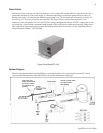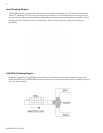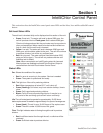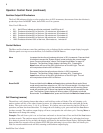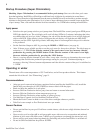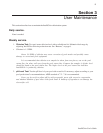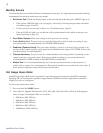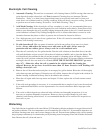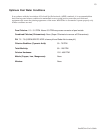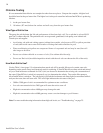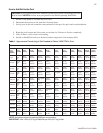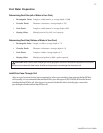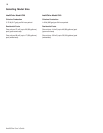11
IntelliChlor User’s Guide
Electrolytic Cell Cleaning
1. Automatic Cleaning. This unit has an automatic cell-cleaning feature (Cell Reversing) that removes
scale deposits from the electrolytic cell. Note Automatic Cleaning does not interrupt Chlorine
Production. “Scale” is a white crusty deposit that forms in excessively hard water or from pool
water that is out of balance and in a scaling condition. If the cell shows excessive scaling, you need
to perform an acid wash cleaning. Proceed to “Acid Wash Cleaning,” Step 2.
2. Acid Wash Cleaning. If the electrolytic cell has a tendency to scale, it is recommended that every
two months the cell be removed and inspected for scale formation and/or debris. Some filters allow
debris to pass through to the cell, possibly lodging between the plates in the cell. A small amount of
scale formation is normal. If by looking through the cell it is observed that there is excessive scale
formation between the plates or debris is present, the cell must be cleaned as follows:
a. Use a high-pressure jet of water from a garden hose. If the cell cannot be reasonably cleaned in this
manner, acid cleaning is necessary.
b. To acid clean the cell: Mix one quart of muriatic acid with one gallon of tap water in a plastic
bucket. Always add acid to the water, never add water to the acid. Always wear eye
protection and use rubber gloves. Always work in a well-ventilated area.
c. Place the cell vertically in a five gallon bucket. Pour the acid solution (as described above) into the
cell until the blades are just covered. Allow the acid solution to bubble, and to clean the blades. The
acid should only be contained in the cell and not around it. A foaming action will begin, which is
caused by scale (calcium carbonate) being dissolved from the plates. If rigorous foaming action does
not begin, the cell does not need to be cleaned (STOP THE CLEANING PROCESS - go on to
step “d”). Otherwise, allow the cell to remain in the solution until the foaming has
stopped. However, do not leave in acid for more than 1/2 hour. Excessive Acid Washing will
damage electrolytic cell.
d. Remove the cell from the bucket and place in an empty five gallon bucket. Rinse the cell thoroughly
with clean tap water and inspect. If deposits are still visible, immerse the cell again in the solution for
further cleaning. Additional acid may need to be added to the solution.
e. Rinse the cell again with clean tap water and inspect. If clean, replace the cell and resume normal
operation.
f. If the acid wash procedure is necessary, it is recommended that a sample of pool water be analyzed
by an authorized IntelliChlor service representative for excessive hardness and/or improper water
balance.
g. If no scale or debris deposits are observed in the cell after two bimonthly inspections, it is not
necessary to continue bimonthly inspections. However, due to possible changes in pool water
chemistry and filtering effectiveness, it is recommended that the cell be removed for inspection at
least twice a year.
Winterizing
Very little chlorine is needed in cold water. Below 59° Fahrenheit, chlorine production is stopped; the unit will
not produce chlorine. This low-temperature cut-off extends the life of the cell. If preventative measures are
not taken, freezing water may cause severe damage to the cell. Prevent freeze damage to the cell by running
the pool pump continuously or winterize the pool by draining water from pump, filter, and all intake and return
lines. Remove the cell, clean and store it.



